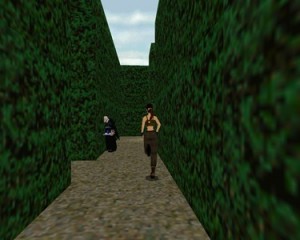Chapter 50 Prezi Presentation
[prezi url=”http://prezi.com/plr5yvqgzk5u/” width=”550″ height=”400″ zoom_freely=”N” ]
Reflective Essay
Reflective Essay
Mazes in Videogames
For as long as I can remember, videogames have been an integral part of my life. Since the age of three, I have encountered a multitude of puzzles and riddles – each of which having developed my ability to tackle problems in the process. Among the array of games I have enjoyed, I have had a decent exposure to mazes, including a most recent adventure in an indie horror game created by a few college students called Labyrinth. It is through this videogame and many others that I have been exposed to the cultural significance of mazes, and continue to appreciate and fear them until this day.
In the PC game Labyrinth you walk around with a torch in a dimly lit labyrinth, all while in the first person. It is a very primal experience; the ambiance in the maze is eerie and filled with fear of the unknown. Random noises can be heard echoing throughout the winding corridors, hinting at the evil that lurks within the maze’s walls. This sensation of mystery and worry is where our cultural relationship with mazes in the West begins. Greek legend has it that Theseus – the mythical founder of Athens – traveled through the labyrinth of Knossos in order to slay a Minotaur (Montfort et al. 35). As the player later discovers, the beast hunting you inside the labyrinth is indeed the same exact Minotaur. The only difference is that the player cannot kill the beast, instead you must run and hide, attempting to find an escape in the process. This added measure of uncertainty and fear makes the game an even more “bewildering and life-threatening space”, and further reflects how we viewed mazes early on in Western history (Montfort et al. 32).
On the other hand, mazes in later eras have a reputation for being playful and exciting diversions. Videogaming particularly follows this structural formula of amusement when mazes are introduced. Most notably, The Legend of Zelda series and Pac-Man both feature these kinds of games, ranging in architecture from the more difficult to the fairly basic. My earliest experience with one of these was a training level in the form of a hedge maze in Tomb Raider II. As expected of Croft Manor’s affluence, an expansive maze of greenery is utilized to help the player get used to controlling Lara. This hedge as well as the outside space surrounding Croft Manor was an add-on that the first installment didn’t feature. The atmosphere is bright and vivid unlike Labyrinth’s interpretation, and instead aims to entertain the player – in the end reflecting the modern cultural perception of exciting maze-like puzzles.
Ultimately, videogames echo the various cultural interpretations that have cropped up throughout Western history. From the horrific labyrinths of Greek mythology to the playful diversions of excitement and wonder, I have been exposed to the cultural significance of mazes utilized in videogame entertainment for decades. Since my very first maze in Tomb Raider II, videogame mazes continue to test my skill as a problem solver, and relentlessly keep me up into the wee hours of the night.
Works Cited
Montfort, Nick, et al. 10 PRINT CHR$(205.5+RND(1)); : GOTO 10. Cambridge and London: MIT Press, 2013. Print.


